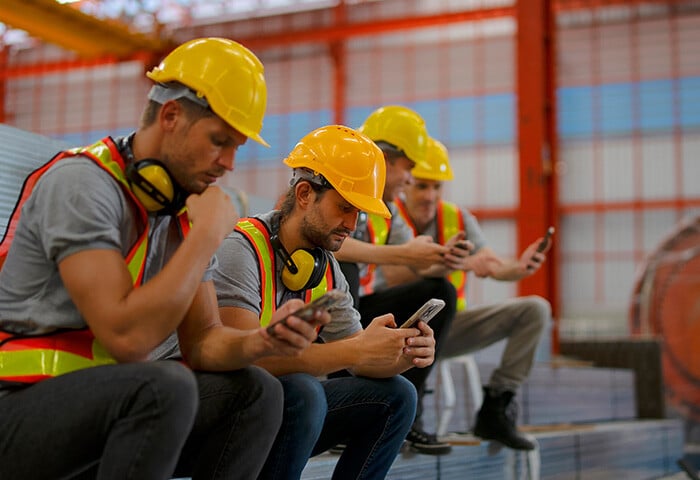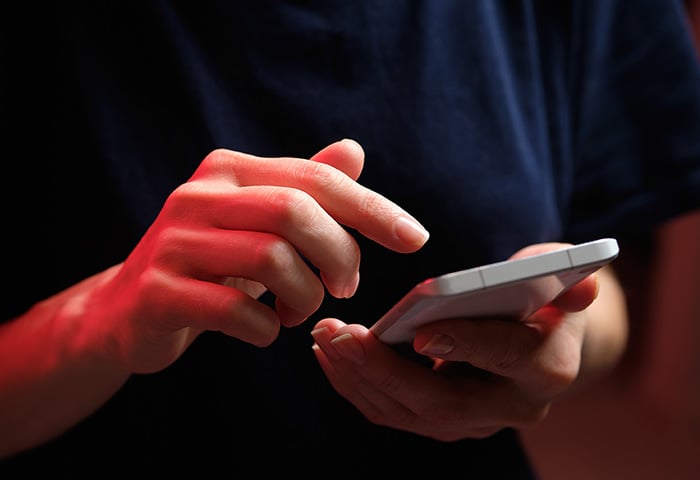What to do if your phone is lost or stolen
If your phone is lost or stolen, your first step is to call or text it and listen for a sound or vibration. Then, use a different device to try to locate your phone using a Find My feature. Keep reading below for more detailed tips. Thankfully, smartphones are better equipped than ever when it comes to protecting your personal data if your phone is lost.
Losing a phone risks exposing your sensitive financial details, private communications, personal photos, and other sensitive data, so you need to act quickly. Depending on how you set up your phone — if you followed the seven best iPhone security tips — you may be able to block the stolen phone from being used or seal off sensitive apps and folders.
(If your phone isn’t lost or stolen and you just want to know what to do to protect it in case it ever is, jump down to our section on how to set up your phone to make sure your data stays safe.)
Here’s what to do if you’re dealing with a lost or stolen phone:
Call your phone or use a mobile app to send an alert
The first thing to try is to call your phone and listen for a ring or vibration. It might simply be in your laundry basket or under your pillow.
Or, depending on how your notifications are set up, try using a different app to message your phone. If you know that a new Snapchat message makes a distinctive ping, ask a friend to send you a snap. The same applies for any other app for which you have notifications turned on. Recovering a lost phone might just take a couple of notifications.
Text your phone
Send a text message to your phone and listen for the sound or vibration. Try sending one over regular cellular data as well as iMessage (or another app that sends via Wi-Fi). You may have left your data turned off and Wi-Fi turned on, or vice versa.
Also, if you lost your phone and someone finds it, they may be able to see the message you sent on the home or lock screen and respond accordingly.
Use the “Find My” feature to lock your phone
The Find My feature was developed as an answer to how to get back a stolen phone. These apps and features work for both iPhones and Androids, and they’re accessible from any device if you know your username and password.
If you’ve lost your iPhone, log into your Apple ID on a different device, go to Find My, and you can see the location of your phone, make it ring, or see the last location before it was switched off.
Find My’s main use is to get your phone back, so you don’t necessarily need to worry if the apps spy on you and violate your privacy. In a certain sense, that’s how these apps are designed, and they only work if you set them up beforehand.
Here’s how to find your iPhone using the Find My feature.
-
Sign in to iCloud or open Find My on another Apple device that’s connected to your iCloud or Apple ID account. The map will show you the phone’s live location. You can click All Devices > iPhone to view more options.

-
If you can’t locate the phone, ensure nobody is allowed to get in. Click Lost Mode to lock your phone with your usual passcode. This step also disables Apple Pay and lets you display address information on the screen so that it can potentially be returned.
If you have an Android phone, here’s how to find your lost phone.
-
Go to Android Find My Device and sign in.
-
Select the lost phone to trigger a notification and see its location. You’ll also see other options like Secure Device, which locks your phone.

Check your online accounts
If you think your phone isn’t just lost but might actually be stolen, checking for strange activity on your online accounts can help you know for sure. If you see logins you don’t recognize, messages you didn’t post, or other unusual activity, that might be a sign that someone has stolen your device and accessed your accounts.
Change your passwords
Changing your passwords quickly can defend against hijacked accounts. Reset the passwords for your most sensitive accounts first, like your email, bank, and social media accounts. Many platforms also give you the option of logging out on all devices. When changing your login credentials, be sure to create strong passwords.
You should also enable 2FA (two-factor authentication) to make it harder for anyone but you to log in. Since this usually requires you to have a phone with you, get a new phone as soon as you can. Otherwise, 2FA may require access to your email account, which is not as secure.
Remotely wipe phone data
If your phone was stolen, you can wipe the phone to ensure your data doesn’t fall into the wrong hands. Wiping your phone data is irreversible — but it’s worth protecting your data at all costs if you can’t get your phone back. Much of your personal info is likely backed up to the cloud, like your photos and emails, so you can always find that later when needed. Here’s how to remotely wipe your phone data if your phone is lost or stolen:
-
iPhone users should first file a claim with AppleCare+ (if they have it). Then, sign into iCloud, tap the lost or stolen device, and choose Erase iPhone.
-
Android users should know that SD cards might not be wiped. With this in mind, go to Android Find My Device and click Erase device.
Wiping your phone’s data remotely is only possible if the phone is connected to the internet and Find My is set up beforehand. The option is also a great trick to use when you want to throw away your old phone or laptop — wipe the data in that case, too.
Before wiping your phone, consider notifying your bank, because they can freeze your credit and debit cards and make sure no money is spent. If payment cards or other personal info have already been compromised, you can report identity theft.
Use the IMEI number to locate your phone
Every phone has a unique IMEI (International Mobile Equipment Identity) number that works like a serial number for identifying it. IMEI numbers are traceable even after the phone has been wiped, and they aid in blocking the phone from further use. However, they can’t be used to locate a phone that’s switched off.
IMEI numbers can be accessed through the Find My apps and features described above. Otherwise, you can find them in the Settings on your phone — in Settings > About on your iPhone and Android.
Unfortunately, some thieves have figured out how to modify a phone’s IMEI number, in which case there’s nothing you can do. We suggest referring back to the change passwords section for further action on how to keep thieves from being able to log in to your phone in the first place.
Use AVG Anti-Theft to locate, lock, or wipe your device
Some security apps include built-in anti-theft features, allowing you to locate, lock, and wipe your device from one place. Here’s how to send commands to your lost or stolen phone using the anti-theft feature in AVG AntiVirus:
-
On a computer or another mobile device, sign in to your AVG account linked to your phone’s Avast AntiVirus app, then select Anti-Theft.
-
From there, you can send the following commands to your phone: Locate tracks your device’s current location and monitors location changes; Lost locks your device, activates a siren on the phone in hopes that the thief will ditch it, and sends the phone’s last location to your AVG account; Wipe or Siren can also be sent as standalone commands.

From your AVG Account, you can also send a message to your lost or stolen phone — this is especially helpful if the phone is simply lost and you want to connect with the person who found it. To begin using the anti-theft feature, you first need to install AVG AntiVirus on your mobile device. From the mobile app, you can enable Anti-Theft and customize the commands that can help you get your phone back.
Contact your mobile carrier
Contact your mobile carrier (like Verizon, Vodafone, or T-Mobile) to see if they can help you locate your phone. They’ll have access to all the calls and messages on your phone, and they can even disable service for it. Your carrier will also help you take additional steps to report a lost phone, and they should be able to help you secure your data.
Contact the police
The police might be able to track your phone with the aforementioned IMEI number. You might also get lucky and find that your phone has been turned in by a stranger. The police may also be able to track your phone without a warrant to recover it.
Most of the solutions above need to be set up before the phone is lost or stolen. Keep reading to learn how and why to take the proper precautions before it’s too late. That way, you can avoid becoming a victim of identity theft and minimize the damage if your phone is ever lost or stolen.
What to do before your phone is lost or stolen
Before your phone is lost — or simply when setting up a new phone — enable all the features that will help you locate, lock, and wipe it remotely. If you lose access to your phone before these features are enabled, there’s little hope you’ll be able to recover it, and then you’ll be left wondering how secure your phone actually is.
Here’s what to do before your phone is lost or stolen:
Turn on remote tracking
The first step is to make sure you can actually use remote capabilities to track down your device if it’s ever lost or stolen.
How to turn on Find My iPhone
-
Go to Settings, tap your name, and select Find My.

-
Tap Find My iPhone, then toggle on Find My iPhone (so it’s green).

How to turn on Find My Mobile on Android
Go to Settings > Biometrics and security. Toggle on Find My Mobile.

How to turn on Anti-Theft in AVG AntiVirus
-
Install AVG AntiVirus on your mobile device.
-
Open the app, tap the Menu (three lines), and select Anti-Theft.

-
Toggle on Anti-Theft at the top of the screen (so it’s green) and ensure all the commands in the list are enabled.

Back up your data
The idea of someone else going through your phone is frightening. But you can back up the iPhone, wipe your lost or stolen phone, and restore all of the data to a totally new iPhone — and all of the settings will be the same. Do this in iTunes when your iPhone is connected to your computer.

Alternatively, iCloud lets you pay a small fee to keep all your data uploaded to the cloud in real time. You can do the same on Google One if you use Android.
Activate one of these services, make sure it’s working correctly, and maybe even download all the files to an external HDD. Then, if someone ever steals your phone, you can easily wipe it clean because you’ll have already backed up all your data.
Protect the lock screen
You can alter the lock screen settings in many different ways to make it impossible to penetrate.
Secure your lock screen on iPhone
Here’s how to add better security to your iPhone lock screen.
-
Go to Settings. Scroll down and tap Touch ID & Passcode (or Face ID & Passcode). You’ll have to enter your current passcode to see the options.

-
There are several settings you can use. If you tap Change Passcode, you can change your passcode to a 6-digit code, making it much harder to crack. Set Require Passcode to Immediately so that it’s required every time the phone is unlocked.

-
You can also add biometric data for easy access. Tap Add a Fingerprint so you can open your iPhone by fingerprint recognition. But first, consider the risks of fingerprint locks.
Secure your lock screen on Android
Here’s how to change the lock screen on your Android phone.
-
Go to Settings > Lock screen.

-
Tap Screen Lock type and choose the security features you want to use.

If you’ve set the lock screen up correctly, the thief might be completely unable to access your personal information.
If you’re a parent, there are also ways to make sure your child’s phone is secure, too.
Don't save passwords to your browser
Saving passwords to your phone’s browser isn’t as good as using a trusted password manager. When you save your passwords to your browser, anyone who uses that browser on your phone (even family members) will be able to log into your accounts.
A password manager works via a master password that allows all of the saved passwords to work (or not work). If you change the master password on your password manager, your phone will automatically log out of every account associated with the saved passwords — unless you re-enter the new master password into your phone.
Protect your messages
Despite its popularity, WhatsApp is far from the most secure messaging app. Not only do Signal and Telegram encrypt your messages, they also come with options to require a PIN code for access. It’s an extra layer of security, especially if your cell phone gets stolen. Your email account can be hacked, too, so strengthening your email security is important.
Also check out the best privacy apps for Android to keep all your information secure, not just your messages. And protect your iOS device with the best iPhone security apps.
Update your phone
Software updates keep your information secure by patching known vulnerabilities in your system, helping you avoid phone viruses and other threats. If you don’t know how to update Android or iPhone, or your Android’s not updating at all, go to your Settings, tap General, and search for Updates.
Add another line of defense for your mobile life
Losing your device is one thing, but it's the photos, messages, and other personal data left vulnerable that really matter. Fight off viruses, other malware, and thieves alike with AVG AntiVirus.
When enabled, the built-in Anti-Theft features will help you remotely locate, lock, and wipe your device. You can even sound a siren to scare a thief, or send your phone a message to establish contact in case your lost phone is found by a good samaritan. Protect your device — and your sensitive data — with AVG AntiVirus today.
.png)
.png)




























